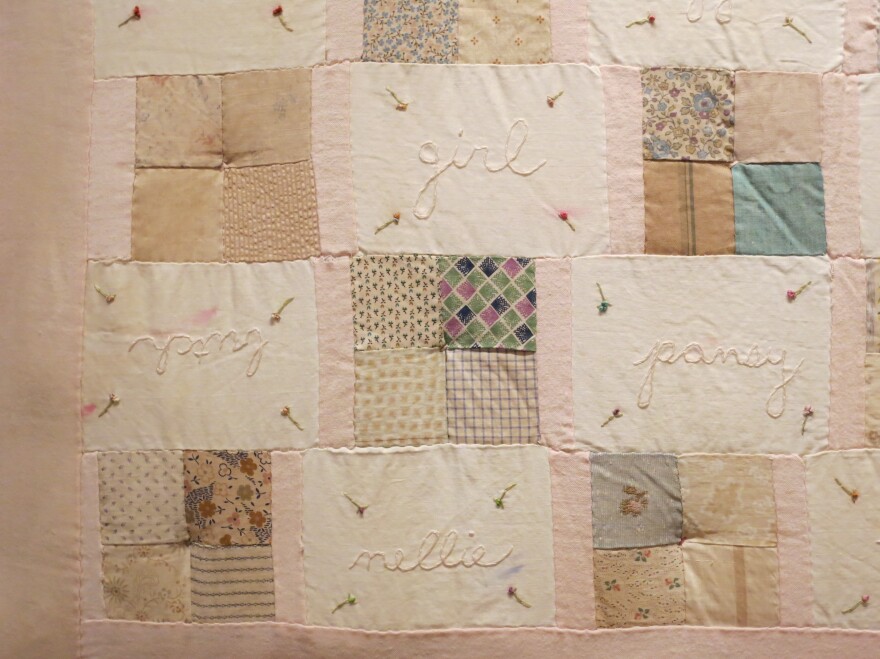On Tuesday I visited a small public space in New York City, the Leslie-Lohman Museum of Gay and Lesbian Art. I went there to see an exhibit called Queer Threads: Crafting Identity and Community and to seek an answer to a question I'd pondered ever since first hearing of the museum the week before:
Is there such a thing as gay and lesbian art?
At the museum, I wandered the exhibit, curated by artist John Chaich. Queer Threads is small enough for a visitor to take in each piece fully and think about the accompanying texts. Representing the works of 24 artists from around the world, the focus is on crochet, embroidery, knitting, macramé and sewing.
The threads in these crafts, the introductory panel explains, "[parallel] the potential for connectivity in our lives as same-gender-loving and gender-non-conforming peoples. Our commonalities may be as thick as a knot or as thin as a string. As individuals we are strands; as communities we are interwoven. Both can be broken or braided."
I like that sensibility, yet wondered: Doesn't it parallel the potential for connectivity in all our lives, regardless of sexual identities?
An answer came to me in the exhibit notes, provided in a pamphlet handed out by the museum staff, and in the artworks themselves.
"All of the featured artists are LGBTQ-identified," writes curator Chaich in the notes. "But not all of the content explicitly is — and that's perfectly queer in this context. ... Queerness embraces diversity and even discrepancy."
Sheila Pepe's "Your Granny's Not Square," made from shoelaces, yarn and hanging hardware, struck me as an excellent illustration of Chaich's point about the show sometimes veering away from an explicit focus on gayness. I learned that Pepe's grandfather had been a shoemaker and her grandmother and mother crafters. Even as Pepe honors her past, though, she subverts it: The traditional granny square becomes, in her hands, something quite novel, a beautiful, airy purple-and-green web that allows light to shoot through it.
Chaich himself, however, does see explicit gayness in this work's "crevices and shadows." With art, what I love most is that there is no right (or wrong) interpretation.
Some pieces in Queer Threads are in-your-face sexual. The explanatory text with a piece by Sonny Schneider proclaims that the artist "uses bold humor and vibrant color to address the urgency of the gay male sex drive and the absurdity of gay pride slogans." A visitor's attention is arrested here!

My favorite piece in the show was Melanie Braverman's Queer, a patch quilt crafted with cotton thread and silk ribbon. I was first drawn to the soft pink-and-white colors, seeing a thing of beauty and comfort. But then I saw the ugly words on the quilt: fairy, poofter and even nastier epithets. I felt destabilized and soon realized that that was Braverman's intent. The text accompanying the work said:
"The harshness of the words contrasts against the softness of the fabric, disrupting the perceived comfort of the quilt just as bullying disrupts the daily social comfort of a queer person."
Yes, there is such a thing as gay and lesbian art.
In the end, for me the primary guiding principle for recognizing this art as gay — even more important than analysis of the works' meaning — turned out to be the artists' self-identification. It's the same principle at work as in art museums dedicated to gender, such as Washington, D.C.'s National Museum of Women in the Arts, or to ethnicity, such as the Museum of Latin American Art in Long Beach, Calif.
In the Leslie-Lohman museum, I felt it in the air a bracing sense that I was a visitor to a proud queer space. It's a space meant to celebrate gay creativity and, yes, connectivity, in the way all art celebrates connectivity in our human community.
Barbara's most recent book on animals will be released in paperback in April. You can keep up with what she is thinking on Twitter: @bjkingape
Copyright 2021 NPR. To see more, visit https://www.npr.org.



